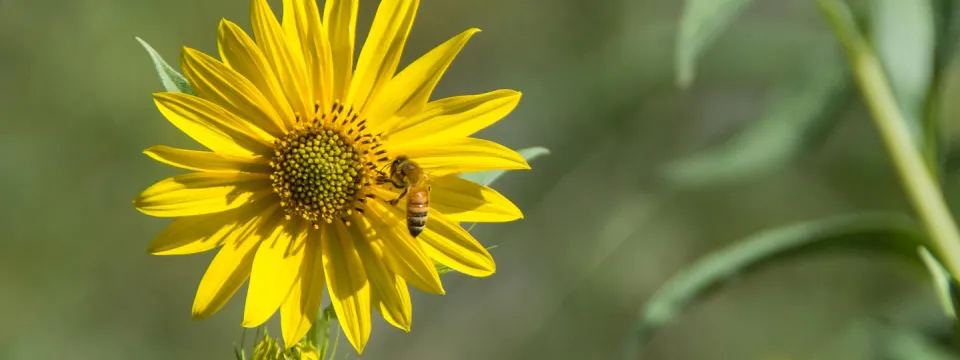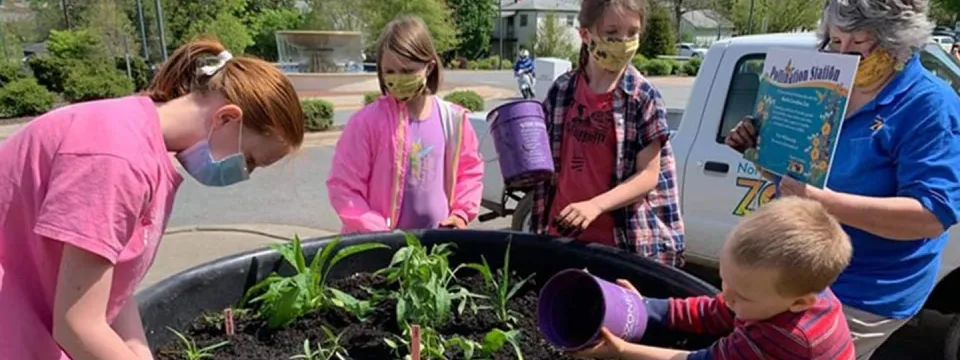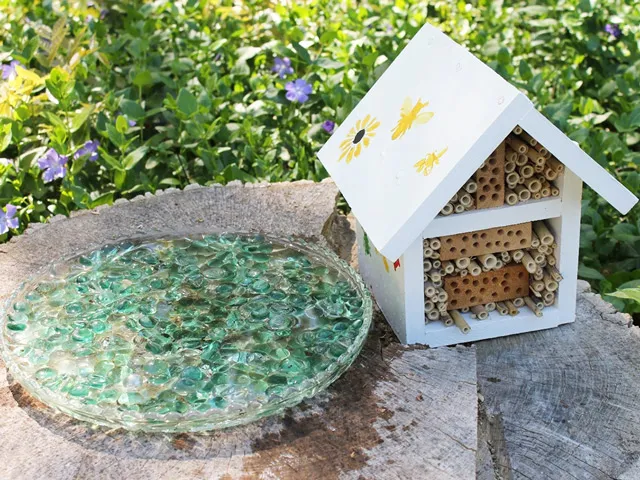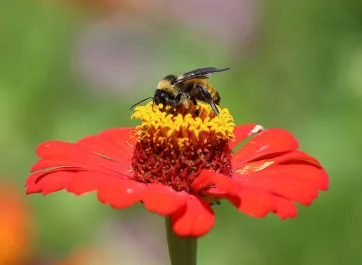Written by Kathy Osborne, KidZone Coordinator, North Carolina Zoo
The monarch butterfly has been getting a lot of press lately, but it is just one of many native pollinators that are in trouble. The North Carolina Zoo is a member of the Association of Zoos and Aquariums SAFE (Saving Animals from Extinction) monarch program which acknowledges that this charismatic butterfly is a flagship species for our many native pollinators. Here are some numbers to help put things into perspective:
There are over 4,000 native bee species in the United States
There are over 750 native butterfly species
There are over 11,000 native moth species
Other pollinators include flies, wasps, beetles, hummingbirds and songbirds as well as a few mammals like bats
So which ones are the “best” pollinators? Hands down, the bee is the most efficient pollinator. Unfortunately, because some of them have stingers, they are the underdog of pollinators.

Pictured Above: Honey bee
The one bee that we know the most about is the honey bee, but it is not a native species. Many of us know they are important for agriculture, but they do not have a monopoly on that market. Another social bee, the bumblebee is also beneficial for agriculture. Did you know that when you enjoy hot-house tomatoes, peppers and eggplants that you are benefiting from the pollination work of the bumblebee? What about the blueberries, cranberries, blackberries and raspberries you put in your cereal or yogurt? The lowly bumblebee helps them too. When you enjoy your zucchini, yellow squash, and onions this summer, thank the bumblebee. Why are bumblebees such efficient pollinators? Buzz pollination! They create that familiar buzzing sound to facilitate the flowers’ release of the pollen. The sound waves literally shake the pollen loose! In addition, the bumblebee is very fuzzy so it collects pollen on all those cute little hairs.
Furthermore, they have pollen baskets on their legs just like honey bees. In the United States, there are forty-five species of bumblebees. Here in the southern United States, these are the most common bumblebees: two-spotted bumblebee, southern plains bumblebee, brown-belted bumblebee, common eastern bumblebee, American bumblebee, and yellow-banded bumblebee. Remember hearing about a bumblebee on the Endangered Species List? That is the rusty patched bumblebee whose decline over the last twenty years or so is around 87%.

Pictured Above: Recent Pollination Station installation at Randolph County Public Library in Asheboro, NC. Family members volunteer to plant, water and tend to the native plants supplied by the North Carolina Zoo.
If there is a botanical garden near you, they will probably have native plant sales. Getting plants from local gardeners is a smart way to make sure you are getting native and healthy plants. These folks are also a great source of information. They will be able to tell you about soil, how much sun/shade, how to feed and much more. So, going native is crucial—plant natives as much as possible! And if you think about it, that makes an incredible amount of good sense. Native plants and pollinators have evolved together. Native plants will be easier for you to grow and care for as they will be more drought tolerant and will be less likely to introduce pests and disease. This also means you will not need to use pesticides (at least you can try to limit your use of pesticides.)
But most bees are not social. No that does not mean they are grumpy and waiting to sting anyone who bothers them. It means they (like many animal species) lead a solitary lifestyle. In the United States, 9 out of 10 native bees are solitary. It also means that they do not live in a hive. Where do they live? Seventy percent are ground nesters while the others use hollow stems, wood, and burrows or nests left by other animals. Some examples of these solitary bees are mason bees, leaf cutter bees, carpenter bees, sweat bees, furrow bees, mining bees, and cuckoo bees. That’s just a sample of our native bees. There are many different sizes, shapes, colors, habits and plants that they visit, but one thing they all have in common: there are less of them each year. The answer as to why their numbers are declining is not simple. Scientists do agree that the main reasons include climate change, habitat loss, overuse of pesticides, and introduced diseases.
What can we do to help bees? We can start with each having our own green space. That could mean our yard, our patio planters, the hanging baskets on our porch, the green spaces in our neighborhood, the local library, our children’s schools. We can use resources such as your local native plant society, master gardeners, extension offices and nearby universities to find out what native plants to use.

Native bee hotel constructed by North Carolina Zoo horticulture technician Charity Cox-Cole and located in butterfly garden in Kidzone, North Carolina Zoo.
Want more ideas to help the bees? Resist the urge to clean up your garden in the fall. Leaving seed heads and stems will help our solitary bees have nesting materials. Maybe you have a picky homeowner’s association and cannot be messy. That can be solved by constructing a nesting box. Constructing native bee nest boxes is a fun family project. There are some commercial ones available. Be sure to use only natural materials and to clean out your boxes every year or so to prevent disease and mold growth. While you are at it, why not provide some water for our hardworking bee friends? You can use a shallow dish or pan that you add marbles, pebbles, rocks or decorator gems to so that the bees have a resting spot where they will not drown. The use of a shallow container prohibits mosquitoes from reproducing in the water. If we all chip in with things we can do, our efforts will help nature’s underdog pollinator—the native bee.

Shallow dish with decorator glass beads and water along with a bee hotel. In the background, you may notice my non-native periwinkle which was planted a long time ago but is kept under control as it can be very invasive. It does offer some pollinator food earlier in the year while many of my native pollinator plants are not yet in bloom.
An excellent resource for planning a pollinator garden in the southern United States (and it is also a great source of information about our native pollinators) is the book--Pollinator Gardening for the South: Creating Sustainable Habitats by Danesha Seth Carley, Anne M. Spafford and published by University of North Carolina Press.
For help in identifying native bees in North Carolina, go to the following link for a free downloadable copy or you can order a printed copy for a small fee: Identify Native NC Bees
For help explaining about pollinators to children, the book A, Bee, See: Who are our Pollinators and Why are They in Trouble? by Kenneth Eade and photographs by Valentina Eade offers clear language and awesome macro photography that makes learning science fun.
Want to learn more?
Dr. Elsa Youngsteadt, Assistant Professor and Extension Urban Ecology Specialist at NC State University shares all about native bees and about her bee hotel design:
And watch this video produced by the Hill Library’s Makerspace at NC State using Dr. Youngsteadt’s plans:


